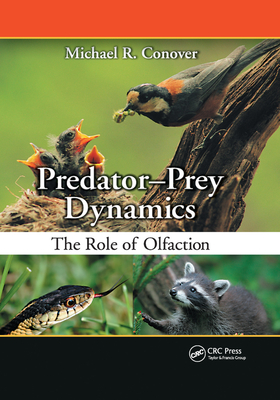By presenting an abundance of scientific evidence throughout the text on olfaction and the olfactory concealment theory, Predator-Prey Dynamics reshapes the way that scientists view animal behavior. The olfactory concealment theory demonstrates that olfaction is an effective method used by predators to locate prey because animals constantly release a stream of odorants. However, animals can minimize their risk of being detected by an olfactory predator by hiding where updrafts, turbulence and suboptimal wind speeds occur (all predictable in time and space). Using published literature to test predictions, this book will help biologists and wildlife professionals manage olfactory predators and their prey.
Humans, being visually oriented, are well versed in camouflage and how animals hide from predators that use vision to locate prey. However, many predators do not hunt by sight; they hunt by scent. This raises the question: do survival mechanisms and behaviors exist which allow animals to hide from these olfactory predators? If so, what are they, and how do they work?
Predator-Prey Dynamics: The Role of Olfaction examines environmental as well as biological and behavioral elements of both predators and prey to answer gaps in our current knowledge of the survival dynamics of species. Beginning with a thorough look at the mechanics of olfaction, the author explains how predators detect, locate, and track their prey using odor trails on the ground or odor plumes in the air. Understanding the physics of airflow is the next step to understanding the potential for manipulating and masking scent. While a bush may conceal an animal visually from a predator, it will not protect an animal from a predator using olfaction. To hide from the latter, an animal needs to hide in locations where turbulence and updrafts will disperse its scent.
The book addresses tradeoffs that animals must make given their dual needs to hide from predators and to procure food and water. Studies of mammalian and avian behavior provide examples on the actual use and efficacy of olfactory camouflage tactics. The book concludes with a redefinition of ecological terms based on the physics of airflow and a summary of the theory and implications of olfactory predator--prey dynamics.
Introducing the mechanics of olfaction and its influence on the behavior of both predators and prey, Predator-Prey Dynamics: The Role of Olfaction presents a new perception of the world and enables us to understand and more effectively manage the delicate survival dynamics of animals in the wild.
Get Predator-Prey Dynamics by at the best price and quality guranteed only at Werezi Africa largest book ecommerce store. The book was published by Taylor & Francis Ltd and it has pages. Enjoy Shopping Best Offers & Deals on books Online from Werezi - Receive at your doorstep - Fast Delivery - Secure mode of Payment
 Jacket, Women
Jacket, Women
 Woolend Jacket
Woolend Jacket
 Western denim
Western denim
 Mini Dresss
Mini Dresss
 Jacket, Women
Jacket, Women
 Woolend Jacket
Woolend Jacket
 Western denim
Western denim
 Mini Dresss
Mini Dresss
 Jacket, Women
Jacket, Women
 Woolend Jacket
Woolend Jacket
 Western denim
Western denim
 Mini Dresss
Mini Dresss
 Jacket, Women
Jacket, Women
 Woolend Jacket
Woolend Jacket
 Western denim
Western denim
 Mini Dresss
Mini Dresss
 Jacket, Women
Jacket, Women
 Woolend Jacket
Woolend Jacket
 Western denim
Western denim
 Mini Dresss
Mini Dresss




